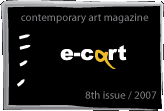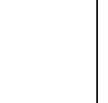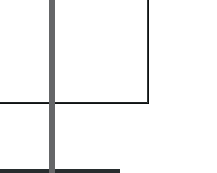VAD (Vector Art Data Bank)
concept: Matei Bejenaru and Cătălin Gheorghe (Vector Association, Iaşi, RO)
assistant: Livia Pancu
VAD (Vector Art Data Bank) is an artistic and research project in its making, which aims at evolving in several directions: the first step would be the identifying and archiving of certain regional artistic and institutional initiatives; the second step involves the selecting and presenting of information about projects that adopt a critical cultural, social and political point of view; and finally, the opening of the archive to public scrutiny, with a view to encouraging interactive communication and collaborative participation.
The VAD archive acquires, processes and exhibits documents (books, catalogues, brochures, postcards, posters, CDs, DVDs and video cassettes) related to artistic and institutional initiatives set up in South-Eastern Europe (Iaşi, Cluj, Bucharest, Chişinău, Kiev, Sofia, Belgrade, Novi Sad etc.).
Conceived with a view to activating a research and mediation coordinate, the VAD archive focuses also on a theoretic, critical and informative coordinate through issuing the publication Vector – art and culture in context as well as on an exhibitional and educational coordinate, through introducing several regional punctual projects in the local and international program of the Vector Gallery. Emerged from the initiative of the Vector Association, these three coordinates are oriented towards creating a friendly environment in order to set up in the near future, a Center for Regional Artistic Expertise.
The VAD project, which was designed to be an “active archive”, puts forward the important issue of the need to reconsider the use of cultural memory, to de-conserve the artistic display and to present the rough as well as the processed data to the general public.
Thus, the VAD archive has turned into an instrument directly involved in activating the process of encouraging cultural awareness and reinvigorating the socio-political behavior typical of a committed cultural thinking, with a view to stress how important it is for the individual, collective and institutional action to come up with an analysis and a critical response in the present circumstances of the transition towards a social, political, economic, historical and cultural order that is strongly influenced by the new local, regional and global strategies.
The archiving practice is based upon the open articulating of the concept, upon an unlimited number of archiving methods and upon the processing of the archival documents, depending on the way in which the curators chooses to apply the formative purposes. This strategic archiving practice is accompanied by a mediation practice, which includes a process of de-archiving the archive through public presentations and exhibitions within a biennial as well as through issuing a publication or organizing gallery displays by working together with regional institutions and independent curators.
The access to regional artistic and cultural information is achieved through interrelating rather than technical stocking, the main stress falling on the re-use of data, with the purpose of identifying their relation to the present and on the contextualization of information depending on the current events. The diversified re-activating of the archive involves a curatorial intervention, which manifests itself in both the researching viewpoint and the artistic approach. The building up, the conveying and the using of the archive depend on all its reinventing through interpretation and display.
Due to the fact that the emphasis falls on the curatorial process rather than the stocking one, the options regarding the administering and distributing of the collected data are made use of in a creative manner, which has in view the use of a heuristic methodology in all the actions: mapping, establishing contacts, organizing visits, meetings, debates or exchanges, selecting, performing curatorial tasks, exhibiting, publishing or providing extended access. The two-way path established between curators and the regional institutions or between artists, critics and institution administrators and the place where the curators work (the Vector Association in Iaşi, Romania) turns into a dynamic element in this process of archiving and publicly displaying the project.
VAD (Vector Art Data Bank) is not a project based only on archiving, researching, editing and artistic displaying; it is also about making contact with artists, critics, curators and institutions within the region.
In the first stage of activating the archive, the selective and interpretative approach mirrors a curatorial and artistic vision that involves a social process of cultural redistribution of certain artistic attitudes oriented towards reflecting circumstantial aspects of the regional socio-political and cultural transition.
The archiving process will also evolve towards investigating the significance of changing the local environment through identifying policies meant to connect the local institutions to the similar ones within the region and the Western space; this means tooling the information regarding the educational platforms of these institutions as well as performing a comparative analysis of the regional artistic contexts.
In these circumstances, the de-archiving practice involves the participation awareness of the audience, who is invited to interact within the projects generated by the activating of VAD with a view to providing a critical improvement in the sphere of acquiring knowledge about the outcomes of recent history, the life of the society and the prospects of the geopolitical restructuration having an immediate impact upon the regional cultural initiatives.
By displaying and mooting different aspects regarding the artistic position and practice, which could create the right environment for putting different attitudes face to face within an extended cultural context, the VAD project initiates a dialogue with the expectations, requisites and needs of an audience that becoming more and more attracted to the idea of (self)learning and cultural exchange.
Projects on display for Social Processes
Vladimir Nikolić (Belgrade)
Rhythm, video performance, 10 min. (2001)
In the video of Vladimir Nikolić, five young people stand in a line as if reporting. Inexpressively, they perform the Christian cross gesture in a hypnotic techno rhythm. In their performance, their gestures become desynchronized and synchronized again in the same mnemonic rhythm. The mechanical encounter between the repetitive gesture of an archaic devotion and the metronomic rhythm of a contemporary sound, creates the symbolic image of a state of affair. The identitarian differences get in the same rhythm where the mystical religious experience and the daily tribal experience confound each other in a collective gesture.
Krassimir Terziev (Sofia)
On the BG Track, video, 7 min. (2002)
By juxtaposing fragments from classical movies, that incidentally mention identity and cultural stereotypes about Bulgaria, and by using images shot on the streets of Sofia, Krassimir Terziev analyses the Westerner's perceptions regarding the exotism of an unknown country. Poverty, tradition and superstition contrast with the “other” image industry. The grotesqueness, absurdness and strangeness of the situations, which draw the “exotic” image of the Bulgarian identity, redistributes the clichés and fictions that appear on the interface between expectations and confrontations.
Veaceslav Druţă (Chişinău)
Portretul lui Brejnev (The Portrait of Brejnev), video performance, 4 min. (2002)
Concerned with the portrait genre, Veaceslav Druţă represents the well-known ”Kremlin leader” by interpreting on a Russian piano accordion a folk song played in the traditional Moldovan weddings. The artist's inexpressive face, looking impassively ahead, is contrasting with the joyful song played with enthusiasm. The symbol of a declining world, Brejnev made the Moldovan life to look like the end of a wedding, when the musicians begin to loose important rhythm, harmony and tempo notions. Towards 2002, a lot of Moldovans began to long for the Soviet Union during Brejnev time, when they were not conscious of being slaves. Not knowing was the sweetest drunkenness.
Arsen Savadov, Georgy Senchenko (Kiev)
Voices of Love, video performance (1994)
The video Voices of Love presents grotesque ballet scenes, using style elements from the Sovietic classical ballet school. A group of sailors from the first battleship of the free Ukraine are dressed in fetishistic tutus, dancing an absurd part with the miniaturist model of their ship. Savadov and Senchenko stand back to back in a continuous pirouette on an engine of a dismembered airplane. Savadov interprets a Ukrainian song on a piano accordion, and Senchenko creates an inoffensive choreography with two Sovietic bombardier models.
Lavinia German, Alex Grigoraş, Bogdan Vătavu (Iaşi)
Pegas, video, 5 min. (2004)
Two young boys are talking on a student hostel terrace from where one can contemplate the industrial cityscape. They are talking about an “inherited” Romanian bicycle without chain. There is a text subtitled in English on the screen, which is describing glorious events of the Romanian people, ending badly. The video is subversively analyzing the contrast between what we hear day by day talking about us, and the international “official discourse” about Romania transmitted by the local authorities.
Nita Mocanu (Bucharest)
Behind the Scene. Question 4, video, 42 min. (2004)
The extract presented in the frame of VAD is a part of a video archive comprising 60 interviews with different persons involved in or related to the Romanian contemporary art scene. Realized in the frame of the Real Fiction project, initiated by D Media Association (from Cluj), this video archive was built, based on a questionnaire which was raised the problem of the artists identities, of defining the artists' profession, the relations between the artists and the different cultural institutions etc.. Behind the Scene. Question 4 is a collage of answers to the question regarding the time, money and artistic creation, directly connected with the artists' jobs, with the relation between the job and the artistic activity, with the relation to the artistic identity, artistic education, cultural institutions, the opportunities and the work planning.
IDEA (Cluj)
magazine and publishing house project, (2001-2006)
The cultural project IDEA consists in editing the IDEA arts + society magazine (from 2003), and a collection of books published by IDEA Design & Print (from 2001). The magazine sections presents an “archive” of texts on art and culture theory and criticism, a “gallery” and an “insert” with an invited artistic project, a series of exhibition reviews and interviews from the Romanian and international “scene” and a series of theoretical text from the area of critical social, political and cultural commentary. On its turn, the editorial program of IDEA project mediates the most actual studies and debates about contemporary art, culture and philosophy, by publishing works by authors like Marius Babias, Roland Barthes, Walter Benjamin, Gilles Deleuze, Jacques Derrida, Thierry de Duve, Vilém Flusser, Michel Foucault, Boris Groys or Peter Sloterdijk.
Mindbomb (Cluj)
posters project, (2002-2006)
Acting in the public space by displaying the social poster, Mindbomb is using art as a medium for social change, initiating dialogues and public debates on social and political themes peculiar to the Romanian contemporary society. In the posters spread on the streets, Mindbomb is submits to the critical commentaries, the nationalism, the corruption, the illegal adoption, the lack of houses, the apathy, the freedom of speech limitation or the destruction of the environment.





















